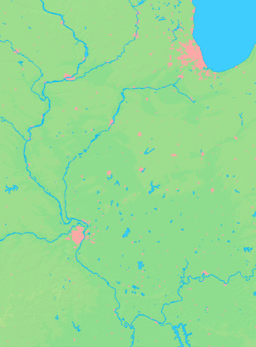Alto Pass, Illinois
| Alto Pass, Illinois | |
| Village | |
.jpg) Alto Pass in 2003 | |
| Country | United States |
|---|---|
| State | Illinois |
| County | Union |
| Coordinates | 37°34′11″N 89°19′8″W / 37.56972°N 89.31889°WCoordinates: 37°34′11″N 89°19′8″W / 37.56972°N 89.31889°W |
| Area | 2.16 sq mi (6 km2) |
| - land | 2.13 sq mi (6 km2) |
| - water | 0.03 sq mi (0 km2) |
| Density | 180.5/sq mi (70/km2) |
| Timezone | CST (UTC-6) |
| - summer (DST) | CDT (UTC-5) |
| Postal code | 62905 |
| Area code | 618 |
  Location of Alto Pass within Illinois
| |
Alto Pass is a village in Union County, Illinois, United States. The population was 391 at the 2010 census, an increase from 388 in 2000. The Bald Knob Cross and Bald Knob Wilderness are nearby.
History
Alto Pass was originally called Quetil, and under the latter name was laid out in 1875 when the railroad was extended to that point.[1]
Geography
Alto Pass is located at 37°34′11″N 89°19′8″W / 37.56972°N 89.31889°W (37.569758, -89.318873).[2]
According to the 2010 census, Alto Pass has a total area of 2.16 square miles (5.59 km2), of which 2.13 square miles (5.52 km2) (or 98.61%) is land and 0.03 square miles (0.08 km2) (or 1.39%) is water.[3]
Bald Knob Cross is located approximately five miles southwest of the village.
Demographics
| Historical population | |||
|---|---|---|---|
| Census | Pop. | %± | |
| 1880 | 166 | — | |
| 1890 | 389 | 134.3% | |
| 1900 | 518 | 33.2% | |
| 1910 | 551 | 6.4% | |
| 1920 | 500 | −9.3% | |
| 1930 | 485 | −3.0% | |
| 1940 | 459 | −5.4% | |
| 1950 | 462 | 0.7% | |
| 1960 | 323 | −30.1% | |
| 1970 | 304 | −5.9% | |
| 1980 | 369 | 21.4% | |
| 1990 | 417 | 13.0% | |
| 2000 | 388 | −7.0% | |
| 2010 | 391 | 0.8% | |
| Est. 2015 | 382 | [4] | −2.3% |
As of the census[6] of 2000, there were 388 people, 159 households, and 111 families residing in the village. The population density was 180.5 people per square mile (69.7/km²). There were 168 housing units at an average density of 78.1 per square mile (30.2/km²). The racial makeup of the village was 87.11% White, 0.77% Native American, 10.57% from other races, and 1.55% from two or more races. Hispanic or Latino of any race were 15.21% of the population.
There were 159 households out of which 25.8% had children under the age of 18 living with them, 59.7% were married couples living together, 6.3% had a female householder with no husband present, and 29.6% were non-families. 27.7% of all households were made up of individuals and 10.7% had someone living alone who was 65 years of age or older. The average household size was 2.44 and the average family size was 3.00.
In the village the population was spread out with 22.4% under the age of 18, 8.8% from 18 to 24, 27.3% from 25 to 44, 26.8% from 45 to 64, and 14.7% who were 65 years of age or older. The median age was 40 years. For every 100 females there were 103.1 males. For every 100 females age 18 and over, there were 104.8 males.
The median income for a household in the village was $33,500, and the median income for a family was $36,406. Males had a median income of $25,583 versus $19,000 for females. The per capita income for the village was $17,288. About 12.0% of families and 15.3% of the population were below the poverty line, including 20.7% of those under age 18 and 6.7% of those age 65 or over.
References
- ↑ Callary, Edward (29 September 2008). Place Names of Illinois. University of Illinois Press. p. 7. ISBN 978-0-252-09070-7.
- ↑ "US Gazetteer files: 2010, 2000, and 1990". United States Census Bureau. 2011-02-12. Retrieved 2011-04-23.
- ↑ "G001 - Geographic Identifiers - 2010 Census Summary File 1". United States Census Bureau. Retrieved 2015-08-01.
- ↑ "Annual Estimates of the Resident Population for Incorporated Places: April 1, 2010 to July 1, 2015". Retrieved July 2, 2016.
- ↑ "Census of Population and Housing". Census.gov. Archived from the original on May 11, 2015. Retrieved June 4, 2015.
- ↑ "American FactFinder". United States Census Bureau. Archived from the original on 2013-09-11. Retrieved 2008-01-31.